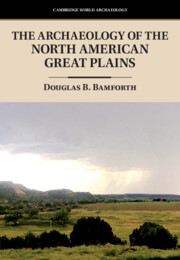Book contents
- The Archaeology of the North American Great Plains
- Cambridge World Archaeology
- The Archaeology of the North American Great Plains
- Copyright page
- Dedication
- Contents
- Figures
- Tables
- Acknowledgments
- Chapter 1 Introduction
- Chapter 2 Where and What Are the Great Plains?
- Chapter 3 Peopling the Continent, Peopling the Plains:
- Chapter 4 Paleoindian Hunters (and Gatherers):
- Chapter 5 Diversity, Environmental Change, and External Connection:
- Chapter 6 Mounds, Pots, Pipes, and Bison:
- Chapter 7 The Context of Maize Farming on the Great Plains
- Chapter 8 Settled Farmers and Their Neighbors, Part 1:
- Chapter 9 Settled Farmers and Their Neighbors Continued:
- Chapter 10 The Plains Village Period, Part 3:
- Chapter 11 One Promise Kept:
- Chapter 12 Afterword
- References
- Index
Chapter 8 - Settled Farmers and Their Neighbors, Part 1:
The Early Plains Village Period, AD 950 to 1250
Published online by Cambridge University Press: 19 November 2021
- The Archaeology of the North American Great Plains
- Cambridge World Archaeology
- The Archaeology of the North American Great Plains
- Copyright page
- Dedication
- Contents
- Figures
- Tables
- Acknowledgments
- Chapter 1 Introduction
- Chapter 2 Where and What Are the Great Plains?
- Chapter 3 Peopling the Continent, Peopling the Plains:
- Chapter 4 Paleoindian Hunters (and Gatherers):
- Chapter 5 Diversity, Environmental Change, and External Connection:
- Chapter 6 Mounds, Pots, Pipes, and Bison:
- Chapter 7 The Context of Maize Farming on the Great Plains
- Chapter 8 Settled Farmers and Their Neighbors, Part 1:
- Chapter 9 Settled Farmers and Their Neighbors Continued:
- Chapter 10 The Plains Village Period, Part 3:
- Chapter 11 One Promise Kept:
- Chapter 12 Afterword
- References
- Index
Summary
By the end of the Woodland times, communities who led very different kinds of lives and who participated in very different pan-regional social and economic networks lived across the Great Plains. The social and adaptive mosaic that they formed underlies the development of horticultural societies on the Plains that began in the 10th century. The people who occupied the northern and Northwestern Plains at the end of Woodland times were mobile and may have been the most sophisticated and intensive big-game hunters that North America has ever seen. Whether or not they directly met people from the Eastern Woodlands, they were an integral part of continent-wide exchange networks with them. South of these hunters, semi-sedentary communities of more generalist hunters and gatherers were scattered across the central Plains, from Nebraska probably as far south as Oklahoma and north Texas. These groups, too, knew their eastern neighbors, and the easternmost of them (in Iowa and eastern Kansas and Nebraska) grew small amounts of domesticated plants. The more northern of these groups shared a general common tradition of Woodland-style ceramic production, albeit with local interpretations of this tradition evident in at least some areas. Late Woodland traditions of collective secondary burials are also especially evident on the Central Plains and speak to organized social networks that bound dispersed residence groups together through rituals that had strong similarities to mortuary rituals to the east. The more southern of these seem to have organized themselves in different ways and connected into the Southeast rather than into the Midwest.
Keywords
- Type
- Chapter
- Information
- The Archaeology of the North American Great Plains , pp. 218 - 261Publisher: Cambridge University PressPrint publication year: 2021



